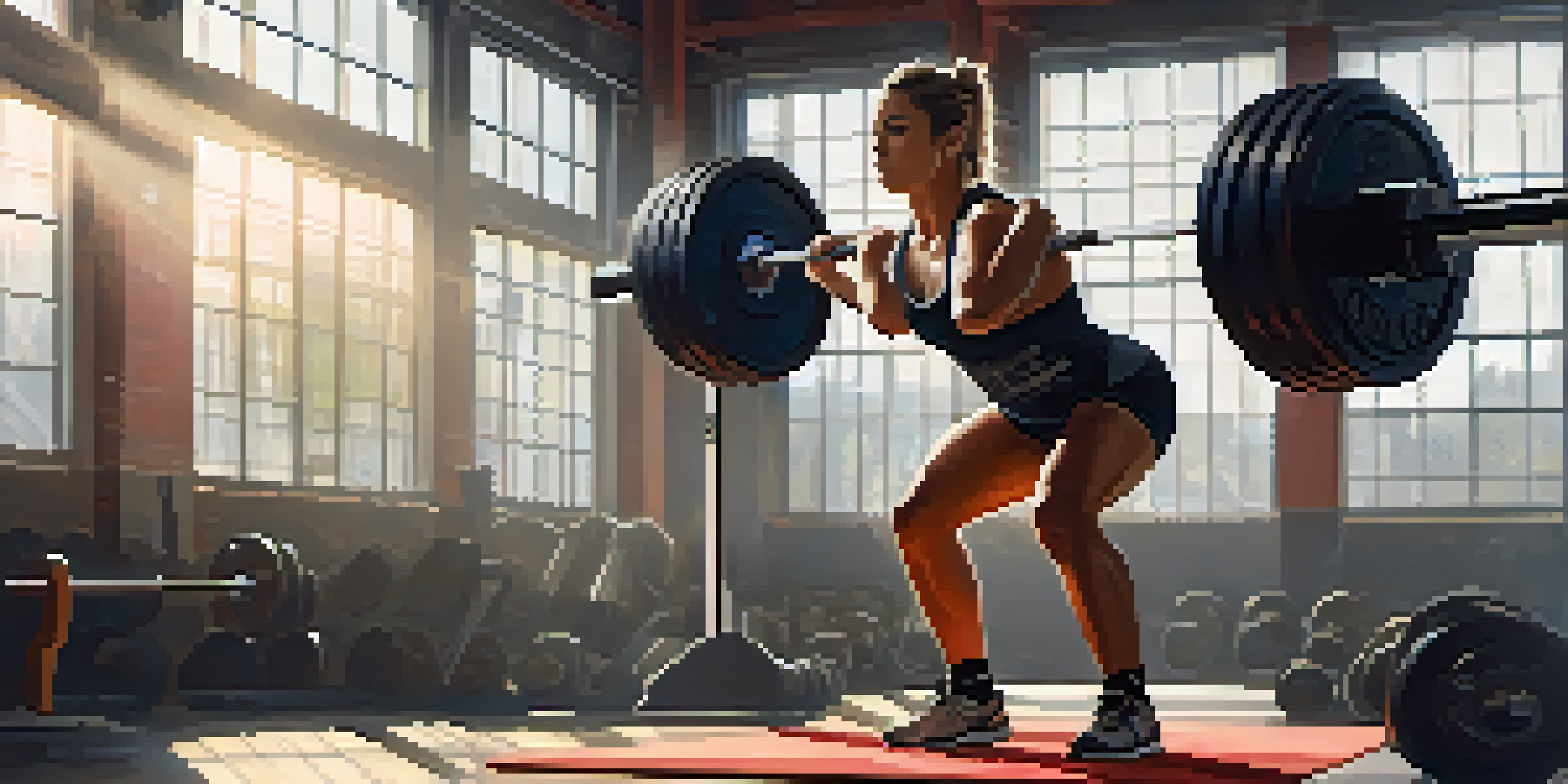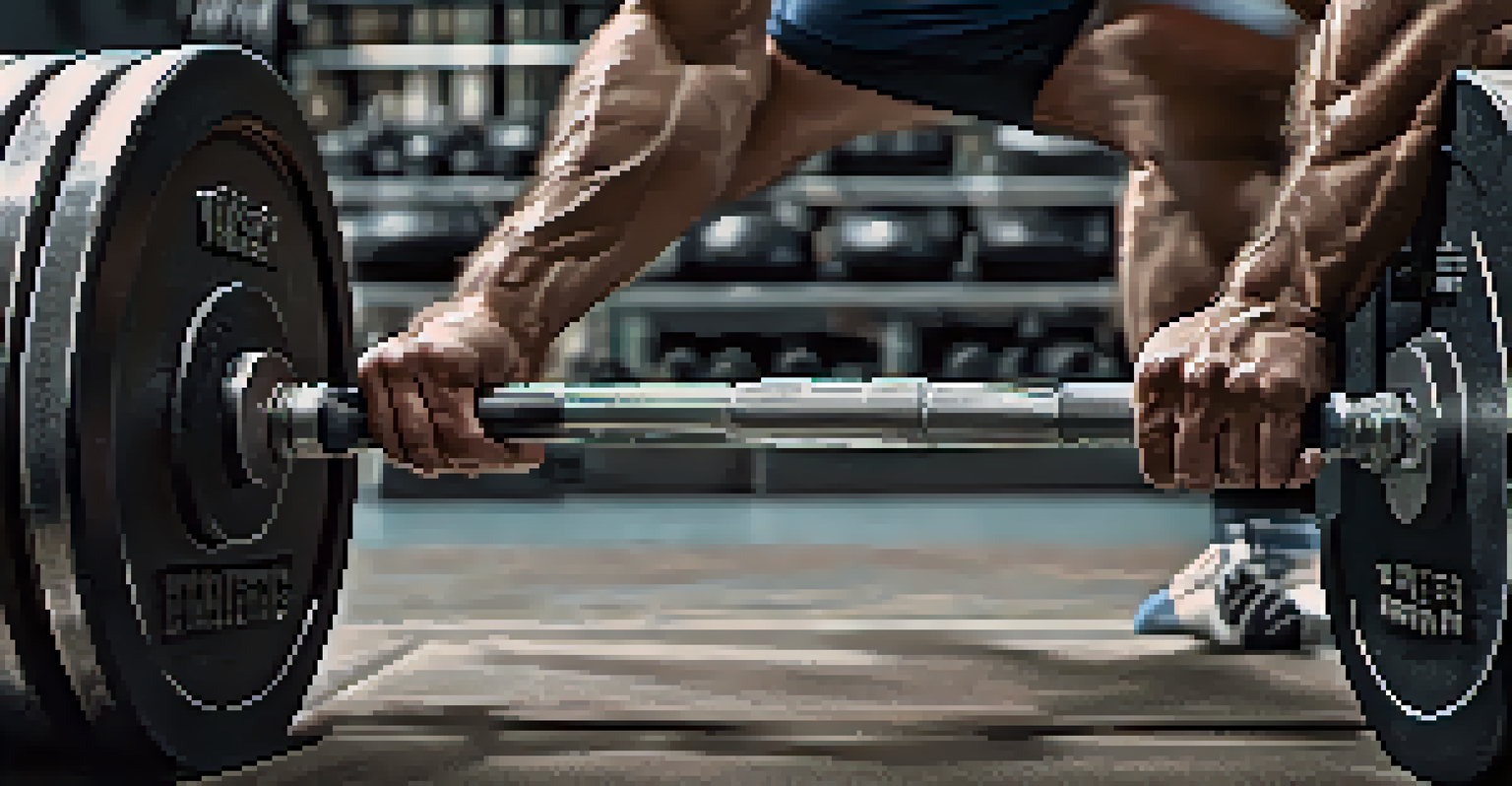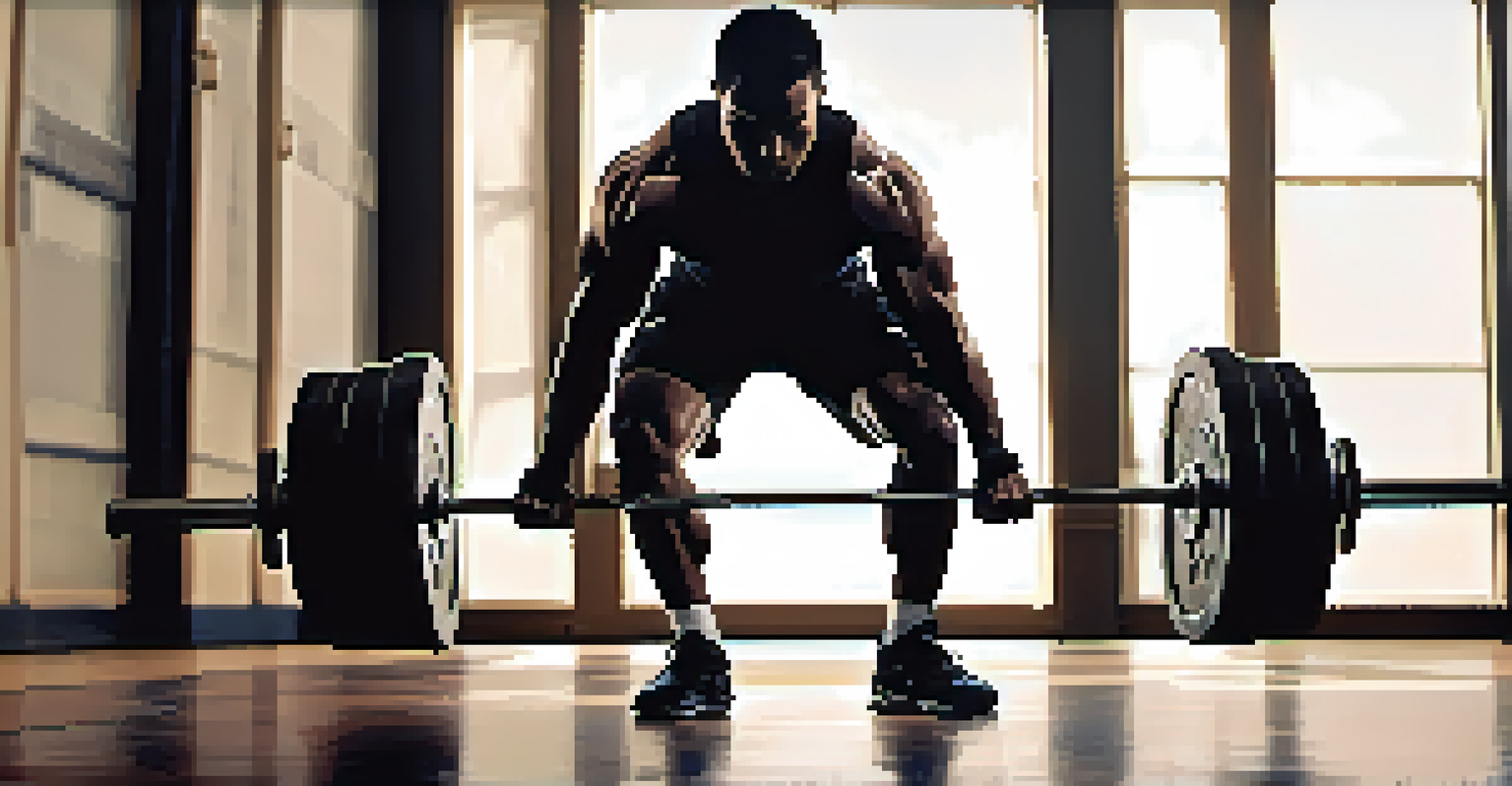Your First Powerlifting Workout: A Step-by-Step Guide

Understanding Powerlifting and Its Core Exercises
Powerlifting is a strength sport that focuses on three main lifts: the squat, bench press, and deadlift. These lifts are not just about lifting heavy weights; they also require proper form and technique to maximize strength gains and reduce the risk of injury. By understanding these foundational movements, you set the stage for a successful powerlifting journey.
Strength does not come from physical capacity. It comes from an indomitable will.
Each of these lifts targets different muscle groups and functions. For instance, squats primarily work the legs and glutes, the bench press focuses on the chest and triceps, and the deadlift engages the entire posterior chain. This variety not only builds overall strength but also contributes to balanced muscle development.
As a beginner, it’s essential to learn the correct techniques for these lifts. Investing time in mastering your form will pay off in the long run, preventing common injuries and ensuring that you can lift heavier weights safely as you progress.
Gathering Essential Equipment for Your Workout
Before you dive into your first powerlifting workout, it's crucial to have the right equipment. At a minimum, you'll need a sturdy pair of shoes with a flat sole, a comfortable gym outfit, and a lifting belt if you plan to lift heavier weights. These items will help you achieve a solid foundation for your lifts and ensure safety during your training.

While many gyms have the necessary equipment, it's worth considering investing in personal gear as you advance. Items like wrist wraps, knee sleeves, and a quality barbell pad can enhance your lifting experience and provide additional support. Remember, comfort and safety are key when pushing your limits.
Core Lifts Define Powerlifting
Powerlifting revolves around mastering three essential lifts: the squat, bench press, and deadlift, each targeting different muscle groups.
Don’t forget about hydration and nutrition! Bringing a water bottle and a snack can help you maintain your energy levels during workouts. Staying hydrated and fueled ensures that you can perform at your best and recover effectively between sets.
Creating Your First Powerlifting Workout Plan
Now that you understand the basics and have your gear ready, it's time to create your first workout plan. A good starting point is to focus on each of the three main lifts, incorporating them into a balanced routine. For example, you could dedicate one day to squats, another to bench presses, and a third to deadlifts.
The difference between a successful person and others is not a lack of strength, not a lack of knowledge, but rather a lack in will.
Begin with lighter weights to get accustomed to the movements and establish good form. Aim for 3-5 sets of 5-8 repetitions for each lift, gradually increasing the weight as you become more comfortable. This structure not only builds strength but also helps develop the muscle memory needed for proper technique.
Additionally, consider adding accessory exercises to target supporting muscle groups. These could include lunges for legs, tricep extensions for the upper body, or core exercises to enhance stability. Accessory work can complement your main lifts and contribute to overall strength gains.
Warming Up: Preparing Your Body for Lifting
Warming up is a crucial step that often gets overlooked, yet it's essential for preventing injury and improving performance. A good warm-up increases blood flow to your muscles and enhances flexibility, making your workout safer and more effective. Aim for at least 10-15 minutes of light cardio and dynamic stretches before you start lifting.
Incorporating specific warm-up sets for each lift can also be beneficial. Start with an empty barbell and gradually add weight, performing 2-3 sets of 5-10 reps. This practice not only prepares your muscles for heavier lifts but also allows you to focus on your form and technique as you progress.
Proper Form Prevents Injuries
Focusing on correct techniques for each lift is crucial for maximizing strength gains and minimizing the risk of injuries.
Remember, a proper warm-up sets a positive tone for your entire workout. By taking the time to prepare your body, you're more likely to lift effectively and safely, helping you achieve your powerlifting goals.
Mastering the Squat: Techniques and Tips
The squat is often referred to as the king of all lifts, and for good reason. It engages multiple muscle groups, including the quads, hamstrings, and glutes, making it a powerhouse move for strength training. When performing a squat, focus on maintaining a neutral spine and keeping your knees aligned with your toes to avoid injury.
To start, stand with your feet shoulder-width apart and lower your body as if sitting back into a chair. Aim to get your thighs parallel to the ground while keeping your chest up and core engaged. It might help to practice bodyweight squats before adding weight to ensure you’ve got the form down.
As you progress, gradually introduce weights, starting with a barbell on your back. Remember to listen to your body and avoid going too heavy too soon. Consistency and proper technique are key in mastering the squat and building your leg strength.
Bench Press Basics: Form and Function
The bench press is a staple in powerlifting that targets the chest, shoulders, and triceps. Proper form is essential to ensure you're maximizing your strength while minimizing the risk of injury. When setting up, lie back on the bench with your feet flat on the ground and grip the barbell slightly wider than shoulder-width.
As you lower the barbell to your chest, keep your elbows at about a 45-degree angle to your body. This position reduces stress on your shoulders and promotes a safer lifting experience. Press the bar back up, driving through your feet and engaging your core for added stability.
Recovery is Key to Progress
Cooling down and adequate post-workout nutrition are vital for muscle recovery and overall strength development.
Like the squat, it’s important to start with lighter weights to practice your technique. You can also incorporate variations of the bench press, such as incline or decline presses, to target different muscle groups. Consistent practice will help you build strength and confidence in this key lift.
Deadlift: Key Techniques for Success
The deadlift is a powerful lift that engages your entire body, particularly the posterior chain, including the back, glutes, and hamstrings. To perform a deadlift, approach the barbell with your feet hip-width apart and grip the bar just outside your knees. Keeping your chest up and back straight, push through your heels to lift the barbell off the ground.
A common mistake is rounding the back during the lift, which can lead to injury. Focus on hinging at the hips and maintaining a neutral spine throughout the movement. As you lift, imagine driving your feet into the ground while keeping the bar close to your body.

As with the other lifts, start with lighter weights to perfect your form. Practicing with a coach or experienced lifter can provide valuable feedback and guidance. The deadlift is not only about strength but also technique, so take your time to master it.
Cool Down and Recovery: Essential for Progress
After completing your workout, it's important to cool down properly. This phase aids in recovery and helps prevent muscle soreness. Spend about 5-10 minutes doing gentle stretches focusing on the muscles worked during your session, such as quads, hamstrings, and chest.
Incorporating foam rolling can also be beneficial in relieving muscle tension and improving flexibility. This technique helps to release tight spots and can significantly enhance your overall recovery process. Taking care of your body is just as important as the lifting itself.
Additionally, ensure you’re fueling your body with the right nutrients post-workout. Consuming a meal rich in protein and carbohydrates helps repair muscles and replenish energy stores. Remember, recovery is where the real gains happen, so give your body the time it needs to adapt and grow stronger.